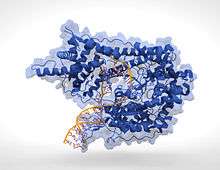T7 RNA polymerase

T7 RNA Polymerase is an RNA polymerase from the T7 bacteriophage that catalyzes the formation of RNA in the 5'→ 3' direction.
Activity
T7 polymerase is extremely promoter-specific and transcribes only DNA downstream of a T7 promoter (TAATACGACTCACTATAG, transcription beginning with the 3' G). The T7 polymerase also requires a double stranded DNA template and Mg2+ ion as cofactor for the synthesis of RNA. It has a very low error rate. T7 polymerase has a molecular weight of 99 kDa.
Structure
T7 polymerase has been crystallised in several forms and the structures placed in the PDB. The different structures are listed here. These explain how T7 polymerase binds to DNA and transcribes it.
Related proteins
Related family members include phage T3 and SP6 RNA polymerases, but this family is also related to the mitochondrial RNA polymerase. The T7 family of RNA polymerases is structurally and evolutionarily distinct from the multi-subunit family of RNA polymerases (including bacterial and eukaryotic sub-families). In contrast to bacterial RNA polymerases, T7 polymerase is not inhibited by the antibiotic rifampicin. Nevertheless, many common functional features are shared with these more complex enzymes.
Application
In biotechnology applications, T7 RNA polymerase is commonly used to transcribe DNA that has been cloned into vectors that have two (different) phage promoters (e.g., T7 and T3, or T7 and SP6) in opposite orientation. RNA can be selectively synthesized from either strand of the insert DNA with the different polymerases. The enzyme is stimulated by spermidine and in vitro activity is increased by the presence of carrier proteins (such as BSA).[1][2]
Homogeneously labeled single-stranded RNA can be generated with this system. Transcripts can be non-radioactively labeled to high specific activity with certain labeled nucleotides.
References
- ↑ Chamberlin, M.; Ring, J., Characterization of T7-specific Ribonucleic Acid Polymerase: I. GENERAL PROPERTIES OF THE ENZYMATIC REACTION AND THE TEMPLATE SPECIFICITY OF THE ENZYME. Journal of Biological Chemistry 1973, 248 (6), 2235-2244.
- ↑ Maslak, M.; Martin, C. T., Effects of Solution Conditions on the Steady-State Kinetics of Initiation of Transcription by T7 RNA Polymerase. Biochemistry 1994, 33 (22), 6918-6924.
Sources
- Martin CT, Esposito EA, Theis K, Gong P (2005). "Structure and function in promoter escape by T7 RNA polymerase". Prog. Nucleic Acid Res. Mol. Biol. 80: 323–47. doi:10.1016/S0079-6603(05)80008-X. PMID 16164978.
- Sousa R, Mukherjee S (2003). "T7 RNA polymerase". Prog. Nucleic Acid Res. Mol. Biol. 73: 1–41. doi:10.1016/S0079-6603(03)01001-8. PMID 12882513.
- McAllister WT (1993). "Structure and function of the bacteriophage T7 RNA polymerase (or, the virtues of simplicity)". Cell. Mol. Biol. Res. 39 (4): 385–91. PMID 8312975.
- Sastry SS, Ross BM (March 1997). "Nuclease activity of T7 RNA polymerase and the heterogeneity of transcription elongation complexes". J. Biol. Chem. 272 (13): 8644–52. doi:10.1074/jbc.272.13.8644. PMID 9079696. - note that the nuclease activity reported here is an artifact.
- Chamberlin, M.; Ring, J., Characterization of T7-specific Ribonucleic Acid Polymerase: I. GENERAL PROPERTIES OF THE ENZYMATIC REACTION AND THE TEMPLATE SPECIFICITY OF THE ENZYME. Journal of Biological Chemistry 1973, 248 (6), 2235-2244.
- Maslak, M.; Martin, C. T., Effects of Solution Conditions on the Steady-State Kinetics of Initiation of Transcription by T7 RNA Polymerase. Biochemistry 1994, 33 (22), 6918-6924.